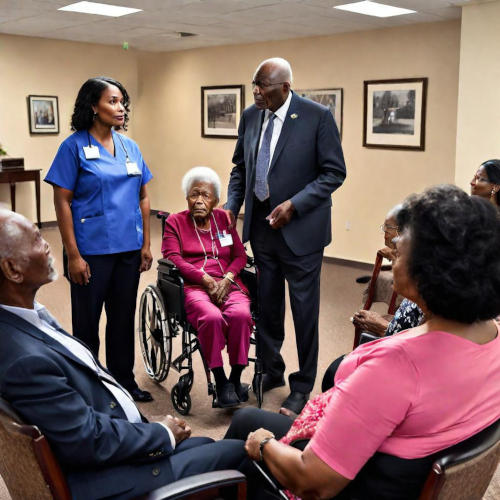How Safety Standards Differ in Nursing Homes: What to Look For
When choosing a nursing home for a loved one, safety is often a top concern. However, not all nursing homes adhere to the same safety standards, which can make the decision process challenging. Safety standards in nursing homes can vary widely depending on state regulations, the facility's management, and the resources available. This article will guide you through the key factors to consider when evaluating the safety standards of nursing homes, offering tips for families on how to make informed decisions with the help of online comparison tools.
1. Understanding Safety Regulations in Nursing Homes
The foundation of a safe nursing home lies in its adherence to state and federal safety regulations. These regulations are designed to ensure that facilities provide a safe environment for residents, but the specifics can vary by state. For instance, Maryland's safety regulations, as outlined in Senate Bill 879, emphasize fire safety measures, emergency preparedness, and infection control. In contrast, Texas's Senate Bill 1525 focuses on resident rights, including protection from abuse and neglect, and ensuring a clean, safe environment.
- Federal Standards: On a federal level, the Occupational Safety and Health Administration (OSHA) provides guidelines that nursing homes must follow to protect both residents and staff. These include standards for workplace safety, infection control, and hazard communication.
- State Variations: Because state regulations can differ significantly, it's crucial to understand the specific safety standards that apply to the nursing homes you're considering. This knowledge will help you ask informed questions during visits and ensure that the facility meets or exceeds the required safety measures.
2. Key Safety Features to Look For
When evaluating a nursing home, there are several key safety features to look for that can indicate a commitment to resident well-being. These features not only ensure physical safety but also contribute to a secure and comfortable environment.
- Fire Safety and Emergency Preparedness: Ensure that the facility has a robust fire safety plan, including accessible fire exits, smoke detectors, and sprinklers. The staff should be well-trained in emergency procedures, and the facility should conduct regular fire drills.
- Infection Control Measures: Especially in the wake of the COVID-19 pandemic, infection control has become a critical aspect of nursing home safety. Look for facilities that follow strict hygiene protocols, have hand sanitizing stations, and provide personal protective equipment (PPE) to both staff and visitors.
- Fall Prevention: Falls are a common hazard in nursing homes, making fall prevention measures essential. Check for non-slip flooring, handrails in hallways and bathrooms, and well-lit pathways. Some facilities may also use technology such as bed alarms to alert staff if a resident is at risk of falling.
3. Evaluating Nursing Home Staffing and Training
Staffing levels and training are directly linked to the safety and quality of care in a nursing home. A well-staffed facility with trained professionals can better monitor residents, respond to emergencies, and maintain a safe environment.
- Staff-to-Resident Ratio: A low staff-to-resident ratio is critical for ensuring that residents receive adequate supervision and care. Facilities with higher staffing levels are generally better equipped to handle emergencies and provide personalized care.
- Training and Certification: Inquire about the training programs that staff undergo, particularly in areas such as emergency response, CPR, and infection control. Staff should also be trained in handling specific conditions that are prevalent among the elderly, such as dementia or mobility issues.
- Background Checks and Screening: To ensure the safety of residents, nursing homes should conduct thorough background checks and screenings on all employees. This process helps prevent abuse, neglect, and other safety concerns.
4. Using Online Comparison Tools to Assess Safety
Online comparison tools can be a valuable resource when researching nursing homes. These tools often provide detailed information on safety ratings, staff qualifications, and inspection reports, allowing you to make a more informed decision.
- Nursing Home Comparison Tool: Facility Finder by Safe Secure Seniors is a comprehensive resource that provides ratings based on health inspections, staffing, and quality measures. It includes information on the facility's compliance with federal safety regulations, as well as any deficiencies noted during inspections.
- State Health Department Websites: Many state health departments also offer online databases where you can access inspection reports and safety violations for nursing homes within the state. These reports can provide insight into recurring issues or areas where the facility excels in safety.
- Third-Party Review Sites: While official sources are crucial, third-party review sites can offer additional perspectives from residents and their families. Look for patterns in the reviews related to safety, such as frequent mentions of falls, infections, or inadequate staffing.
5. Visiting Nursing Homes: What to Observe
While online research is important, visiting the nursing home in person is essential to get a true sense of the facility's safety standards. During your visit, pay attention to the following aspects:
- Cleanliness and Maintenance: A well-maintained facility is usually a safer one. Look for clean, uncluttered hallways, well-kept grounds, and properly functioning equipment.
- Staff Interaction: Observe how staff members interact with residents. Are they attentive and respectful? Do they respond quickly to residents' needs? Positive staff-resident interactions are often a sign of a well-run, safe facility.
- Resident Well-Being: Take note of the residents' condition. Do they appear well-cared-for and comfortable? Are they engaged in activities, or do they seem isolated? The overall well-being of residents can be an indicator of the facility's safety and care standards.
Conclusion: Prioritizing Safety in Nursing Home Selection
Choosing a nursing home for a loved one is a significant decision that requires careful consideration of safety standards. By understanding state and federal regulations, evaluating key safety features, assessing staffing and training, and using online comparison tools, you can make a more informed choice. Ultimately, visiting the facility and observing the environment firsthand will give you the confidence that your loved one will be in a safe and caring environment.




